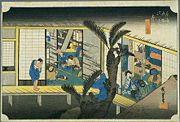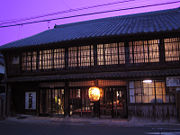.gif)
Akasaka-juku (Tokaido)
Encyclopedia

53 Stations of the Tokaido
The are the rest areas along the Tōkaidō, which was a coastal route that ran from Nihonbashi in Edo to Sanjō Ōhashi in Kyoto.-Stations of the Tōkaidō:...
of the Tōkaidō
Tokaido (road)
The ' was the most important of the Five Routes of the Edo period, connecting Edo to Kyoto in Japan. Unlike the inland and less heavily travelled Nakasendō, the Tōkaidō travelled along the sea coast of eastern Honshū, hence the route's name....
. It is located in present-day Toyokawa
Toyokawa, Aichi
is a medium-sized city of about 180,000 people located in the eastern part of Aichi Prefecture, Japan. The city, founded on June 1, 1943, originally comprised the three formerly independent Hoi-gun towns of Toyokawa , Ko , Ushikubo , and the village of Yawata...
, Aichi Prefecture
Aichi Prefecture
is a prefecture of Japan located in the Chūbu region. The region of Aichi is also known as the Tōkai region. The capital is Nagoya. It is the focus of the Chūkyō Metropolitan Area.- History :...
, Japan
Japan
Japan is an island nation in East Asia. Located in the Pacific Ocean, it lies to the east of the Sea of Japan, China, North Korea, South Korea and Russia, stretching from the Sea of Okhotsk in the north to the East China Sea and Taiwan in the south...
. It was only 1.7 kilometres (1.1 mi) from Goyu-juku, the preceding post station
Shukuba
were post stations during the Edo period in Japan, generally located on one of the Edo Five Routes or one of its sub-routes. They were also called shukueki . These post stations were places where travelers could rest on their journey around the nation...
.
History
Along with the preceding Yoshida-jukuYoshida-juku
was the thirty-fourth of the fifty-three stations of the Tōkaidō. It is located in the center of what is now the city of Toyohashi, Aichi Prefecture, Japan...
and Goyu-shuku
Goyu-shuku
was the thirty-fifth of the fifty-three stations of the Tōkaidō. It is located in Goyu-chō in the city of Toyokawa, Aichi Prefecture, Japan. A pine tree colonnade, one of the few remnants from the Edo period post town, is a well-known tourist spot...
, Akasaka-juku was well known for its meshimori onna
Meshimori onna
. or , literally "woman serving meal" is the Japanese term for the women who were hired by hatago inns at the shukuba along kaidō routes in Japan during the Edo era...
. The classic ukiyoe print by Ando Hiroshige (Hoeido edition) from 1831-1834 depicts a typical inn; the scene is divided in half by a sago palm
Sago Palm
Sago Palm may refer to:* Metroxylon sagu, also called the True Sago Palm* Cycas revoluta, also called the King Sago Palm* Cycas rumphii, also called the Queen Sago Palm* Cycas circinalis, also called the Queen Sago Palm...
in the center. To the right, travellers are taking their evening meal, and to the left, prostitutes are putting on make-up and preparing for the evening entertainment. Due to its reputation, Akasaka was a popular post station with many travellers.

Honjin
thumb|250px|The honjin at [[Inaba Kaidō]]'s [[Ōhara-shuku]]. is the Japanese word for an inn for government officials, generally located in post stations during the later part of the Edo period.-Evolution of Honjin:...
, one sub-honjin and 62 hatago
Hatago
were Edo period lodgings for travelers at shukuba along the national highways, including the Edo Five Routes and the subroutes. In addition to a place to rest, hatago also offered meals and other foods to the travelers...
.
Goyu-shuku was less than 2 km from Akasaka-juku, making them the closest stations on the whole of the Tōkaidō. At Sekigawa Shrine (関川神社) in Otowa, Matsuo Basho
Matsuo Basho
, born , then , was the most famous poet of the Edo period in Japan. During his lifetime, Bashō was recognized for his works in the collaborative haikai no renga form; today, after centuries of commentary, he is recognized as a master of brief and clear haiku...
wrote the following haiku
Haiku
' , plural haiku, is a very short form of Japanese poetry typically characterised by three qualities:* The essence of haiku is "cutting"...
, because they were so close:
- 夏の月 御油より出でて 赤坂や
- Natsu no tsuki / Goyu yori idete / Akasaka ya.
- "By the summer moon, / depart out from Goyu and / reach Akasaka."
When the construction of the Tōkaidō Main Line
Tokaido Main Line
The is the busiest trunk line of the Japan Railways Group , connecting Tōkyō and Kōbe stations. It is long, not counting its many freight feeder lines around the major cities...
bypassed the area, it missed out on many of the economic advantages that the railroad brought. Furthermore, even though the area gained connections to rail networks with the construction of the Meitetsu Nagoya Main Line, it was still unable to flourish because none of the express trains stopped at Meiden-Akasaka Station
Meiden-Akasaka Station
is a train station on the Meitetsu Nagoya Main Line locatedin Toyokawa, Aichi, Japan. It is located 12.5 kilometers from the junction of the Nagoya Main Line at .-History:...
.
Further reading
- Carey, Patrick. Rediscovering the Old Tokaido:In the Footsteps of Hiroshige. Global Books UK (2000). ISBN 1901903109
- Chiba, Reiko. Hiroshige's Tokaido in Prints and Poetry. Tuttle. (1982) ISBN 0804802467
- Taganau, Jilly. The Tokaido Road: Travelling and Representation in Edo and Meiji Japan. RoutledgeCurzon (2004). ISBN 0415310911

